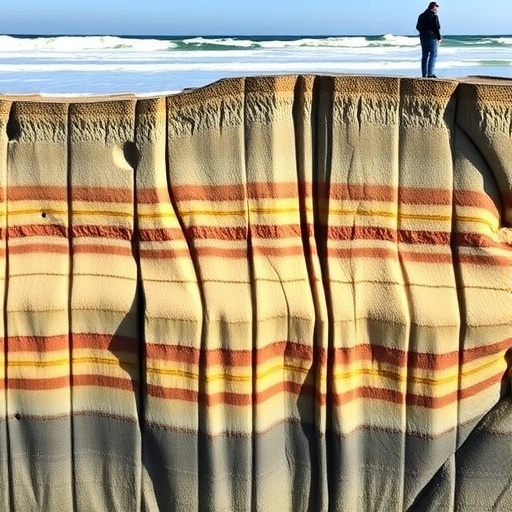In a groundbreaking study published in the journal Commun Earth Environ, researchers have unveiled compelling insights into the ongoing processes of natural ocean alkalinization, which are primarily driven by the erosion of glacial till and the concurrent weathering at the seafloor. The investigation opens new avenues for understanding how natural geological processes can influence ocean chemistry and potentially serve as a method to combat ocean acidification, a pressing issue for marine ecosystems globally.
The oceans have long been recognized as key regulators of Earth’s climate and carbon cycles. This study emphasizes how the erosion of glacial till—composed of a mix of rocks and minerals left behind by glaciers—adds essential minerals to seawater. This mineral influx contributes significantly to the alkalinity of ocean waters. The research highlights the dynamics between natural geological phenomena and the biochemical responses of marine systems.
The team of researchers led by Scholz and colleagues focused on several glacial regions, analyzing sediment samples to quantify the presence and types of minerals released during the glacial erosion process. By employing advanced analytical techniques, they were able to identify specific minerals that promote alkaline conditions in seawater. Such minerals, including calcium and magnesium carbonates, play crucial roles in the buffering capacity of ocean waters, helping to alleviate the adverse effects of increased atmospheric carbon dioxide.
Ocean acidification is a direct consequence of elevated CO2 levels, as the gas interacts with seawater to form carbonic acid. This process threatens marine life, particularly organisms with calcium carbonate shells, such as corals and certain shellfish. Elevated acidity levels can lead to weakened shells and disrupted ecosystems. Thus, understanding the natural mechanisms that counteract this process is vital for both ecological and economic reasons.
The significance of the findings lies not only in linking glacial activity to ocean chemistry but also in providing a potential natural solution to combatting acidification. If ocean alkalinization can be harnessed from glacial areas, it may offer a sustainable method to improve the health of marine ecosystems under siege from climate change. While further research is necessary to fully understand the implications of this study, it sets the stage for innovative approaches to ocean preservation.
Field observations taken from various glacial regions, such as those in Greenland and Antarctica, provided a foundational basis for the study. Systematic sampling of sediments at different water depths revealed a direct correlation between glacial till erosion rates and increases in regional alkalinity levels. The researchers noted that the ocean’s ability to absorb this natural buffer could vary based on local and seasonal conditions, including temperature, water currents, and biological activity.
Accompanying laboratory experiments fortified these observations by illustrating how the addition of mineral-rich sediment influences seawater chemistry in controlled environments. Such experiments not only validate field research but also provide insights into how varying levels of erosion might impact different oceanic regions differently. This multifaceted approach helps illuminate the precise mechanics through which geological processes interact with biological responses in marine environments.
In interpreting the results, the researchers outlined the potential global implications of their findings. As climate change continues to exacerbate ocean acidification, understanding the natural processes that could enhance ocean buffering capacity becomes paramount. This knowledge could inform future conservation strategies aimed at restoring or mimicking these natural systems in regions where human activity has disrupted the natural equilibrium.
Moreover, the authors emphasized the importance of synthesizing these findings within broader discussions surrounding climate action and ocean policy. As nations grapple with the realities of climate change and its impact on marine life, actionable insights derived from this study can help shape effective environmental policies. By integrating evidence-based strategies that promote natural alkalinization, policymakers can make informed decisions that could lead to healthier oceans.
While the study has opened new doors for future research, it also calls for a multidisciplinary approach, combining geology, oceanography, and environmental policy. Collaborative efforts among scientists, institutions, and governments are essential to further explore ocean alkalinization and devise ways to facilitate these natural processes in the face of ongoing change.
However, scholarly caution is necessary. While the potential for natural alkalinization is promising, researchers warn against overly simplistic solutions to complex ecological issues. Each region exhibits unique conditions, requiring tailored solutions that consider local biodiversity and environmental factors. As such, this research advocates for both local and diverse approaches to marine conservation, emphasizing that ecological integrity must remain paramount.
In conclusion, the study conducted by Scholz and his colleagues represents a significant contribution to our understanding of natural ocean processes, particularly as they relate to combating acidification. While natural geological processes provide promise, a balanced approach that includes reduction in greenhouse gas emissions and responsible marine management will be crucial to ensuring the health of our oceans for future generations.
Ultimately, as we delve deeper into understanding the intersection of geology, ocean chemistry, and biology, we inch closer to finding viable solutions to mitigate the impact of human-induced climate change. Ocean alkalinization heralds a potential shift in this narrative, suggesting that nature itself may hold the key to the resilience of our oceans.
Subject of Research: Natural ocean alkalinization through erosion of glacial till and weathering at the seafloor.
Article Title: Natural ocean alkalinization through erosion of glacial till and weathering at the seafloor.
Article References: Scholz, F., Börker, J., Vogt, C. et al. Natural ocean alkalinization through erosion of glacial till and weathering at the seafloor. Commun Earth Environ 6, 974 (2025). https://doi.org/10.1038/s43247-025-03009-2
Image Credits: AI Generated
DOI: https://doi.org/10.1038/s43247-025-03009-2
Keywords: ocean alkalinization, glacial erosion, weathering, ocean acidification, marine ecosystems, climate change, carbon cycle, sediment analysis.




